顕微鏡用高出力LED照明Solis®
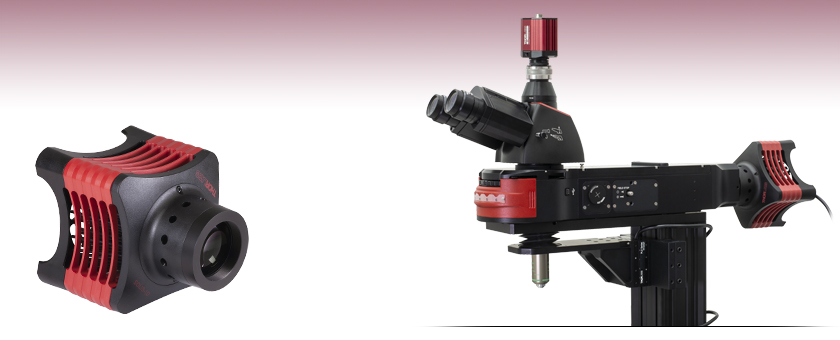
- High-Power LEDs Designed for Microscopy Applications
- Typical Collimated Output Powers from 570 mW to 8.75 W
- Compatible with Thorlabs’ Port Adapters for Cerna®,
Nikon, Olympus, Leica, and Zeiss Microscopes - Two Driver Options
SOLIS-1D
Cold White LED,
8.75 W Output Power (Typical)
Application Idea
A Solis® High-Power LED Installed on the Epi-Illuminator Module of a Cerna Modular Microscope

Please Wait
| Item #a | Color (Click for Spectrumb) | Dominant Wavelengthc | Typical Collimated Output Power |
|---|---|---|---|
| SOLIS-365C | UV | 365 nm | 4.0 W |
| SOLIS-385C | UV | 385 nm | 5.1 W |
| SOLIS-405C | UV | 405 nm | 5.0 W |
| SOLIS-415C | Violet | 415 nm | 7.0 W |
| SOLIS-445C | Royal Blue | 445 nm | 7.1 W |
| SOLIS-470C | Blue | 470 nm | 3.7 W |
| SOLIS-505C | Cyan | 505 nm | 1.5 W |
| SOLIS-525C | Green | 525 nm | 3.1 W |
| SOLIS-565D | Lime | 565 nm | 8.6 W |
| SOLIS-590C | Amber | 590 nm | 570 mW |
| SOLIS-595C | Amber | 595 nm | 1.1 W |
| SOLIS-617C | Orange | 617 nm | 2.4 W |
| SOLIS-620D | Red | 620 nm | 4.72 W |
| SOLIS-660C | Deep Red | 660 nm | 2.7 W |
| SOLIS-740C | Far Red | 740 nm | 3.3 W |
| SOLIS-850C | IR | 850 nm | 3.6 W |
| SOLIS-940C | IR | 940 nm | 3.7 W |
| SOLIS-1D | Cold White | N/Ad | 8.75 W |
| SOLIS-2C | Warm White | N/Ae | 4.0 W |
| SOLIS-3C | Day Light White | N/Af | 4.6 W |
特長
- UV~近赤外(NIR)の波長をご用意(右の表をご覧ください)
- ファンレス設計が振動を発生させず効果的に放熱
- 軽量パッケージで顕微鏡ポートに直接取り付けが可能。液体ライトガイド(LLG)は不要
- Ø48.3 mmの大きな開口からLEDをコリメートして出力
- 対応ドライバ使用時のスマートセーフティ機能を有効にする内蔵エレクトロニクス
- Olympus、Nikon、Leica、Zeiss、Cerna®顕微鏡ポート用アダプタ(別売り。下記参照)に対応
独自のSolis® LEDシステムを構築するには
- Solis LEDヘッド
- LEDドライバ(別売り。いずれかをお選びください)
- DC20:プラグ&プレイドライバ
- DC2200:タッチパネル式ドライバ
- 顕微鏡ポート用アダプタ(対応製品については下の表をご覧ください)
LED照明Solisは、軽量かつ振動のないパッケージから数ワットの光を出力します。高出力で、顕微鏡の落射蛍光照明光路に直接結合できます。コリメートされたLED光を通すØ48.3 mmの大きな開口部は、アダプタ(下記参照)を介してOlympus、Nikon、Leica、Zeissなどの多くの業界標準の顕微鏡の落射蛍光照明光路ほか、当社のCerna顕微鏡の多くに使用されている6キューブの落射蛍光照明光路に取り付けられます。取付けには当社の顕微鏡ポート用アダプタ(別売り。下記参照)を1つLED筐体の先にねじ込み、対応する顕微鏡に固定します。Solis LEDにはLEDの出射ビームプロファイルをさらに均一化する拡散板(型番DG20-1500)が付属しており、試料面に均等に照明を当てる場合にお使いいただけます。この拡散板はお客様による取付けが可能です。
軽量設計のこの製品は、パッシブ冷却が特長です。ファンが内蔵されていないため、通常顕微鏡のセットアップで画質を損なう振動が発生しません。LEDは、通気口付きの127.8 mm x 127.8 mm x 162.0 mmの筐体内のヒートシンクに取り付けられていることにより、効果的に放熱されています。より一層の保護機能としてLEDの内部温度が95 °Cに達すると、プログラムされた内蔵メモリがLEDの自動シャットダウンを作動させ、LEDのオーバーヒートによるダメージを防いでいます。こちらのLEDは 95 °C以下に冷却されると再起動します。 Solis LEDご使用時の性能についての詳細は、「性能」タブをご参照ください。
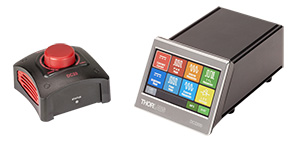
Click to Enlarge
当社ではSolis® LED駆動用にプラグ&プレイドライバDC20(左)とタッチパネル式ドライバDC2200(右)の2種類をご用意しています。
Solis LED用ドライバ
当社ではSolis LED用ドライバを2種類ご用意しています。プラグ&プレイSolis LEDドライバDC20(別売り、下記参照)には1個のノブがあり、LEDの電流制御とON/OFFを行うことができます。また、外部からTTL変調信号を入力するためのBNC端子も付いています。
タッチパネル式LEDドライバDC2200(別売り、下記参照)には直感的に操作できるタッチパネル式インターフェイスが付いており、Solis LEDヘッドに対する基本的な電流制御のほかに高度な変調機能もサポートしています。このドライバでは、LEDの出力を最大輝度に対する割合で設定したり、LEDの駆動電流の設定や調整をしたりすることができます。変調制御が必要な用途向けに、こちらのドライバには内部および外部変調モードとパルスモードが付いています。内部変調モードでは正弦波、矩形波、三角波のほか、長方形のパルス列の生成もできます。外部変調モードでは、ファンクションジェネレータからの任意波形や、他の実験装置とON/OFF状態を同期させるための外部TTL信号にも対応しています。
どちらのドライバも、Solis LEDの内部メモリから電流リミット値を自動的に読み取ってドライバに設定し、LEDを過電流から保護します。こちらの2つのドライバの比較については「Solis LEDドライバ」タブをご参照ください。
| Item #a | Info | Color (Click for Spectrumb) | Dominant Wavelengthc | Minimum Collimated Output Powerd | Typical Collimated Output Powerd | Max Current (CW) | Forward Voltagee | Bandwidth (FWHM) | Emitter Size | Collimating Optics (Installed) | Typical Lifetime |
|---|---|---|---|---|---|---|---|---|---|---|---|
| SOLIS-365C | UV | 365 nm | 3.0 W | 4.0 W | 4500 mA | 4.0 V | 10 nm | 2 mm x 2 mm | LB1723-A ACL25416U-A | >12 000 h | |
| SOLIS-385C | UV | 385 nm | 4.0 W | 5.1 W | 4500 mA | 4.0 V | 12 nm | 2 mm x 2 mm | >29 000 h | ||
| SOLIS-405C | UV | 405 nm | 5.0 W | 3.9 W | 4500 mA | 4.0 V | 12 nm | 2 mm x 2 mm | >40 000 h | ||
| SOLIS-415C | Violet | 415 nm | 5.8 W | 7.0 W | 2000 mA | 14.0 V | 14 nm | 3.5 mm x 3.5 mm | >10 000 h | ||
| SOLIS-445C | Royal Blue | 445 nm | 5.4 W | 7.1 W | 9000 mA | 3.8 V | 23 nm | Ø3 mm | >10 000 h | ||
| SOLIS-470C | Blue | 470 nm | 3.0 W | 3.7 W | 4000 mA | 8.0 V | 34 nm | 2.8 mm x 2.8 mm | >10 000 h | ||
| SOLIS-505C | Cyan | 505 nm | 1.0 W | 1.5 W | 4000 mA | 7.6 V | 42 nm | 2.8 mm x 2.8 mm | >10 000 h | ||
| SOLIS-525C | Green | 525 nm | 2.4 W | 3.1 W | 9000 mA | 5.0 V | 32 nm | Ø3 mm | >10 000 h | ||
| SOLIS-565D | Lime | 565 nm | 5.7 W | 8.6 W | 4000 mA | 13 V (Typ.) | 100 nm | 3.2 mm x 2.6 mm | >10 000 h | ||
| SOLIS-590C | Amber | 590 nm | 350 mW | 570 mW | 1000 mA | 12.5 V | 16.5 nm | 3.2 mm x 3.2 mm | >10 000 h | ||
| SOLIS-595C | Amber | 595 nm | 700 mW | 1.1 W | 700 mA | 14.0 V | 77 nm | 2.8 mm x 2.8 mm | >10 000 h | ||
| SOLIS-617C | Orange | 617 nm | 1.5 W | 2.4 W | 10 000 mA | 4.0 V | 17 nm | 2.6 x 3.2 mm | >10 000 h | ||
| SOLIS-620D | Red | 620 nm | 3.47 W | 4.72 W | 10 000 mA | 3.35 V (Typ.) | 20 nm | 3 mm x 3 mm | >10 000 h | ||
| SOLIS-660C | Deep Red | 660 nm | 2.0 W | 2.7 W | 1000 mA | 12.5 V | 21 nm | 3.2 mm x 3.2 mm | >10 000 h | ||
| SOLIS-740C | Far Red | 740 nm | 2.0 W | 3.3 W | 1500 mA | 13.4 V | 45 nm | 3.2 mm x 3.2 mm | LB1723-B ACL25416U-B | >10 000 h | |
| SOLIS-850C | IR | 850 nm | 2.7 W | 3.6 W | 1000 mA | 13.8 V | 39 nm | Ø6.5 mmf | >40 000 h | ||
| SOLIS-940C | IR | 940 nm | 2.5 W | 3.7 W | 2000 mA | 7.5 V | 55 nm | 3.2 mm x 3.2 mm | >10 000 h | ||
| SOLIS-1D | Cold White | N/Ag | 5.81 W | 8.75 W | 10 000 mA | 4.02 V (Typ.) | N/A | 3 mm x 3 mm | LB1723-A ACL25416U-A | >10 000 h | |
| SOLIS-2C | Warm White | N/Ah | 3.2 W | 4.0 W | 1500 mA | 12.5 V | N/A | 5 mm x 5 mm | >100 000 h | ||
| SOLIS-3C | Day Light White | N/Ai | 3.5 W | 4.6 W | 10 000 mA | 3.5 V | N/A | Ø4.25 mm | >10 000 h |

Click to Enlarge
Solis LEDの典型的なコリメート光の比較。実際のスペクトルはLEDによって仕様範囲内で異なる場合があります。
| General Specifications | |
|---|---|
| Clear Aperture | Ø48.3 mm (Ø1.90") |
| Weight | 1 kg |
| Dimensions | 127.8 mm x 127.8 mm x 162 mm (5.03" x 5.03" x 6.38") |
| Operating Temperature (Non-Condensing) | 0 to 40 °C |
| Storage Temperature | -40 to 70 °C |
| Internal Temperature to Trigger Automatic Shut Off | 95 °C |
| Diffuser (Included) | DG20-1500 |
| Two Retaining Rings (Included) | SM2RR |
LEDの出力パワー
LEDの実際の出力スペクトルやトータル出力パワーは、製造ロットの違いや、温度や電流な どの動作パラメータによって変動します。 適切なLEDをお選びいただくために出力の典型値と最低値を規定しました。 高出力Solis LEDは、最大電流において少なくても、記載されている最低値パワーを出力します。 右のスペクトルは、公称波長が異なるLEDの出力値を比較できるよう、各LEDの典型出力値(コリメート出力)で規格化しています。 このグラフで示されている強度は代表値であり、絶対値ではありません。 すべてのマウント済み高出力LEDの規格化スペクトルデータ(エクセルファイル)はこちらからダウンロードいただけます。

Click to Enlarge
上のグラフは、典型的なパワーで規格化されたSOLIS-1D、SOLIS-2C、SOLIS-3Cのスペクトルを示しています。青い網掛け領域ではスペクトルフラックスが下がります。SOLIS-3Cは、この波長範囲においてより大きな光パワーを必要とする用途(GFPの励起など)に適しています。
室温上昇下での安定性
こちらのSolis® LEDの放熱は安定な出力のために最適化されています。ヒートシンクが直接LEDマウントに取り付けられていることにより適切な熱的接触が得られているため、ジャンクション温度上昇が最小限に抑えられ、LEDの寿命を長くしています。
LEDの特性の1つとして、時間の経過と共にパワーが自然に低下することがあげられます。ほとんどの場合、パワーは緩やかに低下しますが、急速な低下や完全な停止、あるいは故障が突然起こることもあります。 LEDの寿命は、規定の割合のLEDが、あるパワーレベル以下に低下するまでの時間で定義されます。寿命測定のパラメータはBXX/LYYで表され、ここでXXはその種類のLEDで寿命が過ぎた後の出力パワーが規定値のYY%以下になるLEDの割合を示します。当社では、LEDの寿命をB50/L50で表しますが、これはその型番のLEDのうち50%のLEDの光パワーが規定の寿命時間が経過した時に初期値の50%以下に低下するという意味です。例えば、規定の寿命時間を経過したときに、定格出力パワー4000 mWのLED100個のうち50個の出力パワーが、2000 mW以下に低下するということです。
Solis LEDは室温0~40 °Cで動作可能です。実験用に試料や顕微鏡の温度を上げる必要があるなら、室温を上げると便利な場合があります。右のグラフではLED SOLIS-3Cの24時間の出力パワー値を示しています。初期のウォームアップ後、安定的な出力パワーが維持されています。
蛍光物質の励起用に大パワー出力
Solis LED光源はGFPまたはGFPから派生した蛍光タンパク質のイメージング用に設計されています。当社では特定の波長用のLEDのほかにも可視スペクトル全域に対応する広帯域LEDをご用意しております。SOLIS-1D、SOLIS-2C、SOLIS-3Cの広帯域LED光源は多くの蛍光物質に高パワーの励起光を照射します。しかし、右のグラフでご覧いただけるように出力パワーはすべての波長において同じではありません。多くのLEDは470 nm~520 nmで出力パワーが落ちます。これはほとんどのイメージング用途に影響はありませんが、光に敏感な用途ではこの領域でより高いパワーが必要な場合があります。
450 nm~650 nmで比較的一定のパワーを出力するLED SOLIS-3Cは、SOLIS-2Cと比較して高いパワーを出力します。これを証明するために、当社ではSOLIS-3Cの放射照度を測定しました。測定にはLEDから軸上200 mmの位置にディテクタS120VC、そしてその前に480 nmバンドパスフィルタFB480-10(旧製品)を設置しました。フィルタ付きSOLIS-3Cの放射照度は45 µW/mm2でした。これにより、SOLIS-2Cと比較してSOLIS-3Cの方がこの波長範囲で高い出力パワーが必要な場合に適していることが分かります。なお、放射照度の測定値はスペクトル全域の代表値ではなく、470 nm~490 nmでの値です。
Solis® LEDピン配列
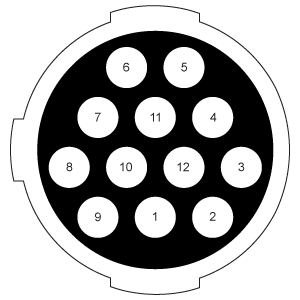
オス型12ピンNeutrik MiniCONコネクタ
| Pin | Connection |
|---|---|
| 1 | LED Cathode |
| 2 | LED Cathode |
| 3 | Not Used |
| 4 | LED Anode |
| 5 | LED Anode |
| 6 | LED Anode |
| 7 | LED Anode |
| 8 | LED Cathode |
| 9 | LED Cathode |
| 10 | Not Used |
| 11 | EEPROM (Data) I/O |
| 12 | EEPROM (Data) Ground |
DIYで取り付け
Solis® LEDは顕微鏡ポートに簡単に取り付けられるよう設計されていますが、光学テーブルやブレッドボードにも取り付けが可能です。 M6タップ穴が筐体の後ろの四隅に付いていて、カスタムの取り付け用途に対応します。前の開口部はSM2内ネジ付きで、当社のSM2レンズチューブや60 mmケージシステムが取り付けられます。
下の写真はSolis LEDを光学テーブルに取り付けた例です。上の写真では、ケージプレートとØ25.4 mm(Ø1インチ)ポストを用いてSolis LEDを取り付けています。一方、下の写真では、Ø50 mm~Ø50.8 mm(Ø2インチ)レンズチューブ、レンズチューブ用スリップリング、Ø12.7 mm(Ø1/2インチ)ポスト、Ø12 mm~Ø12.7 mm(Ø1/2インチ)ポストホルダを用いてSolis LEDを取り付けています。各セットアップに使用している部品は各表に掲載しています。
| Cage Plate Mounting | |||
|---|---|---|---|
| Description | Imperial Item # | Metric Item # | Quantity |
| Solis® LED for Microscopy | See Below for Options | 1 | |
| SM2 (2.035"-40) Coupler, External Threads | SM2T2 | 1 | |
| 60 mm Threaded Cage Plate, 0.5" Thick (Two SM2RR Retaining Rings Included) | LCP34 | LCP34/M | 1 |
| Ø1" Pedestal Pillar Post, 8-32 (M4) Taps | Ø1" Post (RS1.5P8E Shown) | Ø25.0 mm Post | 1 |
| Clamping Fork, 1/4"-20 (M6) Captive Screw | CF125C or CF175C | CF125C/M or CF175C/M | 1 |
| Lens Tube Mounting | |||
|---|---|---|---|
| Description | Imperial Item # | Metric Item # | Quantity |
| Solis® LED for Microscopy | See Below for Options | 1 | |
| SM2 (2.035"-40) Lens Tube | SM2L15 | 1 | |
| Ø2.20" SM2 Slip Rings, 8-32 (M4) Tap | SM2RC | SM2RC/M | 2 |
| Ø1/2" Post, 8-32 (M4) Setscrew | Ø1/2" Post | Ø1/2" Post | 2 |
| Ø1/2" Post Holder | Ø1/2" Post Holder | Ø1/2" Post Holder | 2 |
| Post Holder Base | BA2 | BA2/M | 1 |
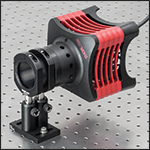
Click to Enlarge
レンズチューブSM2L15を1個、レンズチューブ用スリップリングSM2RC(/M)を2個、Ø1/2インチポストを2本、ポストホルダBA2(/M)を1個用いて光学テーブルに取り付けられたSOLIS-1D
| Components for Cerna® Compatibility |
|---|
| Epi-Illumination |
| CSE2100 or CSE2200 Epi-Illuminator Module with Turret for Six Filter Sets |
| SM2A56 Dovetail Adapter |
 Click to Enlarge
Click to EnlargeLEDを正しく固定すれば、その他の支持は必要ありません。
 Click to Enlarge
Click to EnlargeSolis® LEDと落射照明モジュールCSE2100の接続
Cerna®顕微鏡システムでのSolis®の使用
Solis® LEDには狭帯域または広帯域のスペクトルを有するタイプがあり、当社のCerna顕微鏡プラットフォームにおいて様々な用途にお使いいただけます。
- 蛍光顕微鏡
- 落射型(反射型)顕微鏡
- 近赤外(NIR)・赤外(IR)顕微鏡
Solis LEDはCerna顕微鏡の落射照明用光源としてお勧めしており、落射照明モジュールCSE2100またはCSE2200に取り付けることができます。
Solis LEDを落射照明モジュールに取り付けるには、D3Tオス型アリ溝&SM2外ネジ付きアダプタ(型番SM2A56)が必要です。まずアダプタをしっかりとSolis LEDにねじ込みます。アダプタの落射照明モジュールへの取り付けにはアリ溝を使用します。アダプタとLEDをモジュールの背面に挿入し、2 mm六角レンチを用いて側面の止めネジ(セットスクリュ)を締めてアリ溝を固定します。詳細は右の写真をご覧ください。また顕微鏡のアリ溝での接続については落射照明モジュールの製品ページをご覧ください。
Solis LEDを透過照明型の構成に使用する場合には当社までご連絡ください。
当社ではSolis® LED駆動用に2種類のドライバをご用意しております。DC20はベーシックなモデルで、LEDの発光強度は上部のコントロールノブと、変調用の外部TTL信号入力端子を用いて制御します。より高度な用途向けのドライバDC2200では、タッチパネル式のインターフェイスからLED電流の制御、内部または外部変調モードの選択ほか、様々な操作ができます。下表では主なコントローラの特長の比較がご覧いただけます。
| Solis® LED Driver Selection Guide | ||
|---|---|---|
| Item # | DC20 | DC2200 |
| Photo (Click to Enlarge) |  | 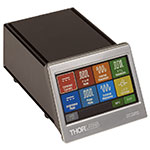 |
| LED Current / Forward Voltage (Max) | 1 to 10 A / 5.0 to 14.0 Va | 1.0 A / 50.0 Vb 2.0 A / 35.0 Vb 4.0 A / 15.0 Vb 5.0 A / 10.0 Vb 10.0 A / 5.0 Vb |
| Noise and Ripple (1 Hz to 10 MHz, RMS, Typical) | <400 µA | <100 µA from 0.0 to 4.0 A <200 µA from 4.0 to 10.0 A |
| Internal Modulation Modes | - | 0.1 Hz to 20 kHz (PWMc Mode) 1 µs to 10 s On or Off Time (Pulse Mode) 20 Hz to 100 kHz (Internal Modulation Mode with Sine, Square, Triangle Waveforms) |
| External Modulation (Arbitrary Waveform) | - | DC - 250 kHz [Small Signal Bandwidth (Sine)]d |
| TTL Modulation (External) | DC to 1 kHz (Square Wave, PWMc) | DC to ≥18 kHze |
| LED Control Interface | Knob to Control LED Current, BNC Port for TTL Modulation | Easy-to-Navigate Touchscreen Interface, Brightness and Constant Current Operating Modes, Internal and External Modulation Modes, SMA Port for External Modulation Accepts TTL Signal or Waveform from a Function Generator, USB Interface for Remote Control |
| Current Limit | Automatically Read and Set from the Solis LED's Internal Memory to Protect the LED from Overdriving | |
| External Software Interface | No | DC2200 GUI |
| Other Compatible LEDs | - | Mounted Collimated Fiber Coupled MCPCB Mountedf |
ドライバDC2200用ソフトウェア
ソフトウェアは下記のリンクよりダウンロードいただけます。
| Posted Comments: | |
哲司 小山
(posted 2023-12-05 11:28:47.673) ケーブルは付属してますか?
付属の場合の長さを教えてください. dpossin
(posted 2023-12-05 09:32:23.0) Dear 哲司 小山,
Thank you for your feedback. The cable length of our SOLIS is 2m. ruichen fu
(posted 2023-11-17 11:35:41.767) I would like to ask if you have the ZEMAX files for SOLIS-470C. Thanks. fmortaheb
(posted 2023-11-20 04:11:37.0) Thank you very much for contacting us. I will reach out to you directly regarding your inquiry. user
(posted 2023-06-26 18:00:43.387) Hello, What is the divergence angle for the Solis? Thanks, Liza wskopalik
(posted 2023-06-28 09:07:13.0) Thank you very much for your feedback!
The divergence angle of the SOLIS LEDs is typically in the range of 10° (full angle). There are however differences between the different wavelength versions because these use different LED chips.
I will contact you directly to provide further assistance. Yigao Yuan
(posted 2022-01-12 18:29:36.597) I want to shrink down the beam size to 2-5 mm on the optical table, could you give me some advice. soswald
(posted 2022-01-17 03:20:13.0) Dear Yigao Yuan,
thank you for your feedback. Beam expanders can be used in reverse to reduce the beam size of the emitted 48.3 mm beam:
https://www.thorlabs.de/newgrouppage9.cfm?objectgroup_id=1580
The GBE15-A would result in ~3.2 mm beam diameter for example. Kumar Satheesh
(posted 2021-11-17 04:59:19.207) I learned that It is possible to increase the beam diameter of the SOLIS-445C with the help of external optics to achieve 75 mm diameter.
ACL7560U-A - Aspheric Condenser Lens, Ø75 mm, f=60 mm, NA=0.61, ARC: 350-700 nm (https://www.thorlabs.de/thorproduct.cfm?partnumber=ACL7560U-A)
If we order above lenses, do we need to install by ourselves, or will it be installed at factory itself?
If we need to install by ourselves, please give me manual or some instructions, we can try to do it.
Could you please let me know what all other items are needs to be ordered, to achieve 75 mm diameter. This planning helps us to avoid any surprises in the field and make sure we are good to go with our planned experiments.
The following items are something we picked from the website. Could you help us.
1. SOLIS-445C - High-Power LED for Microscopy, 445 nm (Royal Blue), 5.4 W (Min) ://www.thorlabs.com/thorproduct.cfm?partnumber=SOLIS-445C
2. DC20 - High-Power Driver for Solis® LEDs, 10 A Max, 14.0 V Max
3. ACL7560U-A - Aspheric Condenser Lens, Ø75 mm, f=60 mm, NA=0.61, ARC: 350-700 nm
The manual says the following is included
• collimating optics LB1723A, ACL25416U-A
• Diffuser DG20-1500;
• 2 retaining rings SM2RR
The doubts are:
Do we need to order any other lens or diffuser to achieve the 75 mm beam diameter?
Do we need to order any extra-large retaining lens?
Do we need to order to spanner wrench SPW604 ?
If you clear my doubts and confirm the part number, that would be amazing for me to go the next step to buy the items. wskopalik
(posted 2021-11-17 08:07:19.0) Thank you for your inquiry!
I will contact you directly to talk about your application in more detail. Ulrich Leischner
(posted 2021-04-28 08:08:49.62) can you please give me a Zemax-model of this LED-Light source? I would like to know the exit angle of the light. What is the etendue like? are the LED-emitter closely spaced or is there a gap in between the LEDs?
there are 4 x anode and 4x cathode mentioned in the pin diagram. are there 4 LEDs that can be driven individually, or are all LEDs driven by the same connector serially?
Regards
Ulrich Leischner soswald
(posted 2021-05-06 04:48:31.0) Dear Ulrich,
thank you for your feedback. I have contacted you directly to further discuss your application and provide assistance. Lev Frisman
(posted 2021-02-27 06:57:15.7) Dear Sir / Madam, do the SOLIS LD sources have an eye / skin safety certificate? In particular, which class does the SOLIS-525C system correspond to?
Thanks and best wishes, soswald
(posted 2021-03-01 10:53:22.0) Dear Lev,
thank you for your feedback. The risk group of our respective SOLIS-LEDs is listed in their spec sheets. The SOLIS-525C is classified as RG2 - Moderate Risk Group according to EC 62471:2006, Photobiological Safety of Lamps and Lamp Systems. Satheesh Kumar
(posted 2020-11-07 11:15:50.61) Hi,
I am interested to buy SOLIS 445 C LED. My requirement is 75 mm collimated Spot diameter. Is it possible to make this possible using any external optics like expander etc...
What if the power if we measure 50 mm from the top surface of my sample?
Is it possible to combine 445, 525 and 623 SOLIS LEDs using combiner with collimated o/p of 75 mm diameter? wskopalik
(posted 2020-11-10 10:06:11.0) Dear Satheesh,
Thank you very much for your inquiry!
I will contact you directly so we can find a good solution for your application. Simon Meaney
(posted 2020-03-05 22:25:33.147) Do you have any available data on the rise and fall times of SOLIS LED's using the DC2200 driver?
I'm interested in the white LED's (SOLIS-3C as an example), I assume these are phosphor coated?
How do these times compare to a narrowband SOLIS LED (SOLIS-623C as an example)?
Thanks nreusch
(posted 2020-03-09 04:49:54.0) This is a response from Nicola at Thorlabs. Thank you very much for your inquiry! While we do not explicitly specify rise times for our SOLIS LEDs, we can provide some data on what you can expect. When combining DC2200 with any SOLIS LED, the driver electronics will limit the rise time. The external modulation mode of DC2200 allows up to 250 kHz, which leads to a period of 4 µs. Depending on the exact LED and operation settings (e.g. modulation with 50% of max current or 100% of max current), we measured rise times in the 1-2 µs range for our broadband SOLIS LEDs, which is comparable to what you could expect with the electronic limitations of the DC2200 modulation. Even though LEDs with narrower spectral intensity distribution will have a shorter rise time, you will not be able to make use of these shorter life times with our drivers. We will contact you directly to provide some data. per-olof.larsson
(posted 2019-02-20 09:40:54.993) 1. I presently have a 100 W short arc mercury lamp (Osram HBO) on my Nikon Eclipse 400 microscope. It is not optimal for delivering light in the 450-500 nm region. Will your Solis-470C make a better job? How much better? How can I find out the difference? Literature reference? Diagrams? I really need a high light output.
2. Can I easily attach the Solis to my microscope ?
3. With the DC 2200 driver the light can be modulated. I probably want to use it in e.g. 1 ms flashes spaced 100 ms - 1 s apart. I suppose that is possible? Have short flashes a "square profile", i.e. is the rise time and descent time very short?
4. Can I coordinate the flashes with the exposure by my Andor DU-897 camera?
Thanks in advance - Best, P-O L wskopalik
(posted 2019-02-26 07:20:37.0) This is a response from Wolfgang at Thorlabs. Thank you very much for your inquiry!
I will answer your questions one by one:
1. The SOLIS-470C has a typical output power of 3.7 W with a dominant wavelength of 470 nm. So it emits most of its power in the spectral range you need. The Osram HBO lamps emit light in a wider spectral range and also emit the light in all directions. So it is unfortunately hard to compare the two light sources without further information about the HBO lamp and the way it is used in the microscope.
2. We offer the adapter SM2A17 to mount the SOLIS LEDs to Nikon Eclipse microscopes.
3. Modulations like this are possible on the DC2200. You can use the "Pulse Mode" to generate pulses with on and off times between 1 µs - 10 s. Rise and fall times are typically in the µs range. So for pulses of 1 ms you can assume a square profile.
4. The DC2200 has an external modulation input. So you could e.g. synchronize the DC2200 and your camera with an additional external pulse or signal generator.
I will contact you directly so we can talk about the open questions. russoblanc
(posted 2018-07-12 14:13:24.58) Hello,
I have an Olympus BX51WI microscope equipped with a conventional fluorescence source (mercury lamp). I would like to change to a LED based light source. Has the Solis-3C enough power to excite GFP and tdTomato in living slices of the brain? Can I adjust the power finely to apply the proper level of excitation without bleaching a fluorophore?
I´m also interested in a compressor for vibration isolation tables. Your makes 30db noise at 1 m....is that comparable to the noise a fridge makes? Can this compressor feed several vibration isolation tables? I currently have two.
Thank you very much.
Best,
Raul swick
(posted 2018-07-19 05:19:01.0) This is a response from Sebastian at Thorlabs. Thank you for the inquiry. The Solis-Series could be driven with the LED driver DC2200.
At the LED driver it is possible to precisely adjust the electrical current so, yes, it is possible to adjust the optical power.
If the optical power will be sufficient to excite GFP and tdTomato depends on the optical setup.
Basically the optical power from the Solis-Series should be sufficient for such applications.
The compressor only runs when the vessel becomes too empty to fill the table,
so it is only going to run every couple of days for a few 10s of seconds depending on how much the table get moved.
You can run 2 tables per compressor, but will need a pressure regulator (PTA013) for each table, after the compressor. philipp.leippe
(posted 2018-06-14 19:49:07.193) Will the adapter SLSLLG3 couple the SOLIS efficiently to a 5mm LLG? nreusch
(posted 2018-06-20 09:39:28.0) This is a response from Nicola at Thorlabs. Thank you very much for your inquiry! In order to achieve an efficient coupling, the NA of lens and LLG need to be chosen carefully. For the SOLIS series, however, it is also important that heat can be dissipated efficiently. We performed some tests showing that the SLSLLG3 might not be the best choice for our SOLIS LEDs, because it does not allow for sufficient air circulation. I will contact you directly for further assistance. pchiang5
(posted 2017-08-28 16:59:43.2) Hello,
I would like to install the LED light source on my axiovert 135. However, I do not have the illumination adapter (connecting tube between light house and filter holder) on the microscope. Is it possible to use your Lens Tubes instead? if yes, could you provide a specific combination of part number for the purpose?
please see below for the information of the illumination adapter:
http://www.ccmr.cornell.edu/wp-content/uploads/sites/2/2015/11/Axiovert_100_135_135M.pdf
Thanks swick
(posted 2017-08-30 03:10:08.0) This is a response from Sebastian at Thorlabs. Thank you for the inquiry. I will contact you directly for assistance. massimo.baroncini
(posted 2017-07-08 00:37:14.977) Is it possible to couple a SOLIS LED with an optical fiber to make a high power fiber coupled led? swick
(posted 2017-07-12 03:20:05.0) This is a response from Sebastian at Thorlabs. Thank you for the inquiry.
In general it is possible to attach optical fibers or liquid light guides to our Solis-Series via the SM2-thread at the output aperture. The optical power which can be coupled into the fiber this way, would be less than what our standard fiber-coupled LEDs (MxxxFx-Series) provide.
I have contacted you directly for assistance. james.a.strother
(posted 2017-05-17 16:19:05.607) Would it be possible to put together a Solis LED with a wavelength closer to 470nm? The 445nm offering is a bit too blue-shifted for the two most common fluorophores, GFP and Alexa Fluor 488. Osram makes a high power 460nm LED that would be much better. swick
(posted 2017-05-19 03:04:35.0) This is a response from Sebastian at Thorlabs. Thank you for the feedback. I will contact you directly for discussing the LED you have mentioned. wandner
(posted 2017-05-04 12:06:58.73) Dear Sir / Madam,
are there Solis High Power LEDs available with a wavelength at about 740 nm?
Best regards,
Karl Wandner swick
(posted 2017-05-08 03:35:05.0) This is a response from Sebastian at Thorlabs. Thank you for the inquiry. At the time we do not offer Solis High Power LEDs near to 740nm.
I will contact you directly to discuss alternative solutions. peh1
(posted 2017-02-21 19:36:51.57) dear hornet, i bought
E3633A 200W Power Supply, 8V, 20A or 20V, 10A
from keysight tfrisch
(posted 2017-02-24 09:32:56.0) Hello, thank you for your feedback. While we have not used this supply, we appreciate your leaving a recommendation for other customers who need a solution before our coming release s.m.hornett
(posted 2017-01-04 10:18:50.54) Is it possible to supply a cheap on/off power supply for these LED's? swick
(posted 2017-01-05 04:26:29.0) This is a response from Sebastian at Thorlabs. Thank you very much for the inquiry.
We will release a lower priced LED driver for the Solis-Series in the near future. I will contact you directly to provide further information. reynolds.gw.2
(posted 2016-11-09 09:02:44.617) Hi,
Can you offer a Solis High power LED at the 700 (ish) nm wavelength?
Thanks,
Geoff wskopalik
(posted 2016-11-14 11:12:13.0) This is a response from Wolfgang at Thorlabs. Thank you for your inquiry!
We will evaluate if a SOLIS LED at this wavelength can be customized. I have already contacted you directly to further discuss your requirements. |
こちらのページでは当社が販売するすべてのLEDをご覧いただけます。More [+]をクリックすると、下の各LED製品の波長をご覧いただけます。
| Light Emitting Diode (LED) Selection Guide | ||||||
|---|---|---|---|---|---|---|
| Click Photo to Enlarge (Representative; Not to Scale) |  |  |  |  |  |  |
| Type | Unmounted LEDs | Pigtailed LEDs | LEDs in SMT Packages | LED Arrays | LED Ring Light | Cage-Compatible Diffuse Backlight LED |
| Light Emitting Diode (LED) Selection Guide | ||||||
|---|---|---|---|---|---|---|
| Click Photo to Enlarge (Representative; Not to Scale) |  |  |  |  |  |  |
| Type | PCB- Mounted LEDs | Heatsink- Mounted LEDs | Collimated LEDs for Microscopyb | Fiber- Coupled LEDsc | High-Power LEDs for Microscopy | Multi-Wavelength LED Source Optionsd |


Click to Enlarge
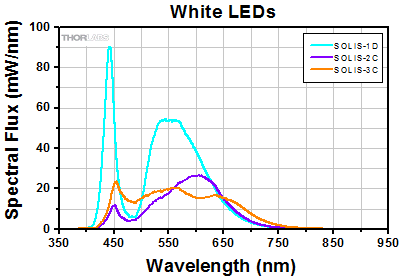
Click to Enlarge
Excel File with Normalized and Scaled Spectra
狭帯域と広帯域Solis® LEDの出力の比較です。公称波長が異なるLEDの出力パワーを比較できるよう、各LEDの典型出力値を規格化しています。このデータは代表例です。すべてのSolis LEDの規格化ならびに換算されたスペクトルのエクセルファイルのデータは、上のリンクをクリックしてダウンロードいただけます。
- 典型的なLEDコリメート光の出力パワー:570 mW~8.75 W
- UV~近赤外(NIR)の波長をご用意
- オーバーヒートによるダメージを防ぐ自動シャットオフ機能
- Ø48.3 mmの大きな開口部
- LED寿命: 10 000時間以上
- LEDドライバDC20ならびにDC2200に対応(下記参照)
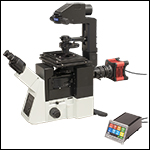
Click to Enlarge
LED SOLIS-1DをアダプタSM2A13(下記参照)でOlympus製顕微鏡に取り付け。ドライバはDC2200(下記参照)を使用。
Solis® LEDは顕微鏡用途向けに設計された高出力LEDです。軽量パッケージは、防振かつファンレスの設計となっており、当社の顕微鏡ポート用アダプタ(下記参照)を使用して顕微鏡ポートに直接取り付けられます。各LEDのレンズチューブ内にはコリメートレンズが付いており、開口部はØ48.3 mmと大きいです。内蔵のEEPROMチップには波長や最大電流など重要な動作情報が保存されており、またLEDの自動シャットオフ機能の制御も行います。内部温度が95 °Cを超えると、損傷防止のためにLEDは自動的にシャットダウンされます。
白色系のSolis LEDの多くは、人間の目が最も明るく感じる波長に相当する主波長があります。当社の冷白色、温白色、ならびに昼白色LEDは、相関色温度(最も近い色に見える黒体放射の温度)を使って表せる広いスペクトルを有しています。一般的に温白色LEDはタングステン光源に近いスペクトル、冷白色LEDは、スペクトルの青色成分が強く出ています。蛍光顕微鏡の用途やカメラのホワイトバランスには冷白色LEDが適しています。温白色LEDに比べてほとんどの波長において発光強度が高いからです。昼白色LED SOLIS-3Cの出力パワーは470~520 nmの波長範囲において高くなります(詳細は「性能」タブをご覧ください。
付属の拡散板は、コリメートレンズの前に取り付けてください。取り付けには固定リングSM2RRを2個(付属品)とスパナレンチSPW604(別売り)を使用します。SM2ネジ深さは各Solis LEDによって異なります。取り付けの際はLEDの電源を切り、筐体の温度が十分下がっていることを確認してください。また拡散板が2つ目のコリメートレンズに接触し、傷を付けないようご注意ください。
典型的な用途では、顕微鏡用アダプタを使用してLEDを直接顕微鏡ポートに取り付けます。またカスタムの取り付け用途向けにM4タップ穴が筐体の後ろの四隅に付いています(詳細は「DIYで取り付け」のタブをご覧ください)。 こちらのSolis LEDは、家庭用照明としての使用はできません。

| DC20 Key Specificationsa | |
|---|---|
| LED Current (Max) | 1 to 10 A |
| LED Forward Voltage (Max) | 5.0 to 14.0 V |
| LED Current Limit Accuracy | ±(1% + 25 mA) |
| TTL Modulation Frequency | DC to 1 kHz |
| Modulation Waveform | Square Wave / PWM |

Click to Enlarge
Solis® LEDをシンプルに駆動するDC20
- 当社の顕微鏡用光源Solis® LEDの駆動用として設計
- LEDの発光強度はダイヤルで容易に調整可能
- 電流リミット値を自動的に設定してLEDを保護
- 最大駆動電流:10 A
- LED最大順方向電圧:14 Vまで対応
- BNCコネクタから外部TTL変調信号を入力可能
ドライバDC20は当社のすべてのSolis LEDを簡単に制御できるように設計されています。設定や使用方法も簡単で、タッチパネル式LEDドライバDC2200の高度な機能までは必要としないSolis LEDのご利用者に便利な製品です。ドライバDC20ならびにDC2200の比較については「Solis LEDドライバ」のタブをご覧ください。
LEDに供給される電流は、ドライバ上部のノブを回すことにより制御します。上部パネルのLIMITと記載された位置は、接続されたSolis LEDの最大電流値に対応します。ドライバはSolis LEDの内部メモリに保存された電流リミット値を自動的に読み取ってドライバに設定し、LEDをオーバードライブから保護します。ノブを押すと、LIMIT位置に対するその時のコントロールノブの位置(比率)に応じた電流値でLEDをオンにするか、またはオフにします。また、ドライバの筐体背面にあるBNC入力端子に外部TTL信号を入力して、LEDを変調することも可能です。TTL信号の仕様要件については「仕様」タブをご覧ください。
ユニット側面の3色LEDは接続されているLEDのステータスを示しており、LEDのオン・オフ(赤外LEDには便利)、LEDが正常に動作しているか、エラーが発生していないかといった情報が表示されます。
なお、ドライバDC20は当社のSolis LEDの内部エレクトロニクスに特化して設計されているため、そのほかのLED製品の駆動には使用しないでください。

| DC2200 Key Specificationsa | |
|---|---|
| LED Current / Forward Voltage (Max)b,c | 1.0 A / 50.0 V 2.0 A / 35.0 V 4.0 A / 15.0 V 5.0 A / 10.0 V 10.0 A / 5.0 V |
| LED Current Accuracyc | ±(0.1% + 2 mA) for 0 to 4.0 A ±(0.1% + 4 mA) for 4.0 to 10.0 A |
| LED Current Resolution | 0.1 mA |
| Internal Modulation | Waveforms: Sine, Square, Triangle Frequency Range: 20 Hz to 100 kHz |
| External Modulation Small Signal Bandwidthd | DC - 250 kHz |
| External TTL Modulation Frequencye | DC to ≥18 kHz |
- Solis® LED用ドライバ
- 駆動モード:定電流モードと輝度モード
- 内部変調ならびにパルスモード
- 周波数、デューティサイクル、パルス数は調整可能
- 波形:正弦波、矩形波、三角波
- 外部トリガならびに外部変調
- USBインターフェイスを介したリモート制御
LEDドライバDC2200には、当社の高出力Solis LED用のタッチパネル式インターフェイスが付いており、上記のドライバDC20よりもさらに高度な機能が搭載されています。最大出力電流は10.0 Aで、最大順方向電圧は50 Vです。 左の写真に示すデバイス前面パネルからローカルに制御するほか、背面にあるUSB 2.0ポートを使用してPCから制御することも可能です。
グラフィカルユーザーインターフェイスのメインメニューでは、定電流モード、輝度モード、内部または外部パルスモード、TTL変調など、LEDの動作に関する選択をすることができます。内部変調モードならびにパルス駆動モードでは、外部のファンクションジェネレータを使用せずにLEDの強度を変調することができます。ドライバの背面にあるSMA入力端子には、任意波形の外部変調信号や、LEDのオンオフ状態を外部機器と同期させるためのTTL信号(High/Low)を入力することができます。

Click to Enlarge
タッチパネル式のインターフェイスではLEDの輝度調整ができます。輝度モード(Brightness Mode)ではLEDを電流リミット値で動作させた時にその輝度が100%になります。
こちらのドライバには、USB 2.0ポートとSolis LED用接続端子のほかにもう1つのLED接続端子があり、そこには当社のマウント付きLED、コリメータ付きLED、ファイバ出力型LEDなどを接続できます*。筐体の後ろ側には、お手持ちの非常停止スイッチをインターロック回路に接続するためのコネクタや、静電気放電防止製品と一緒に使用できる接地用ジャックが付いています。
Solis LED用プラグ&プレイドライバDC20とタッチパネル式LEDドライバDC2200の詳細な比較については上の「Solis LEDドライバ」タブをクリックしてご覧ください。仕様の詳細はLEDドライバDC2200の製品ページでご覧いただけます。
*注:どちらのLED接続端子を使用しても、ドライバが同時に制御できるのは1つのLEDのみです。


Click to Enlarge
Olympus製顕微鏡に取り付けられたSolis LED

Click to Enlarge
アダプタSM2A13を付けたSolis® LED
このSolis® LEDには、当社のOlympus、Nikon、Leica、 Zeiss製の顕微鏡用SM2外ネジ付きポート用アダプタをお使いいただけます。 対応する顕微鏡については、下表をご参照ください。
Solisの筐体と顕微鏡セットアップが寸法的に適合し、機械的干渉が生じないことをご確認ください。例えば、Olympus製IX71顕微鏡の透過照明ポートにSolis LEDを取り付けるには、アダプタSM2A13のほかに型番SM2L05の長さ以上のØ50 mm~Ø50.8 mm(Ø2インチ)レンズチューブが必要になります。
 Products Home
Products Home




















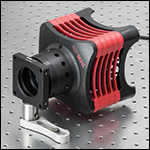
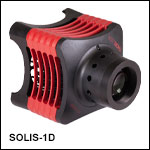
 ズーム
ズーム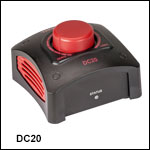






 顕微鏡用高出力Solis LED
顕微鏡用高出力Solis LED